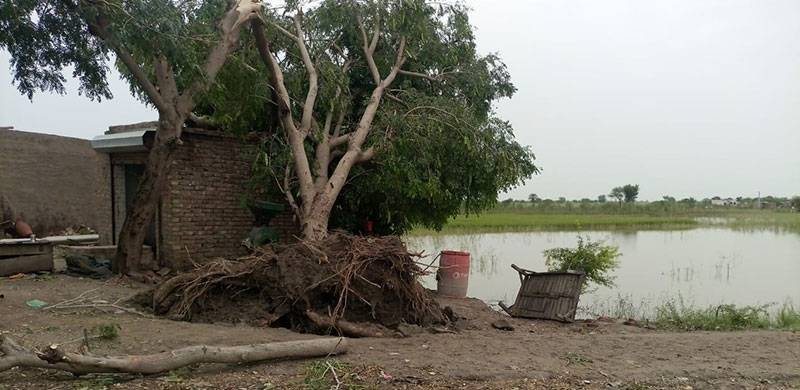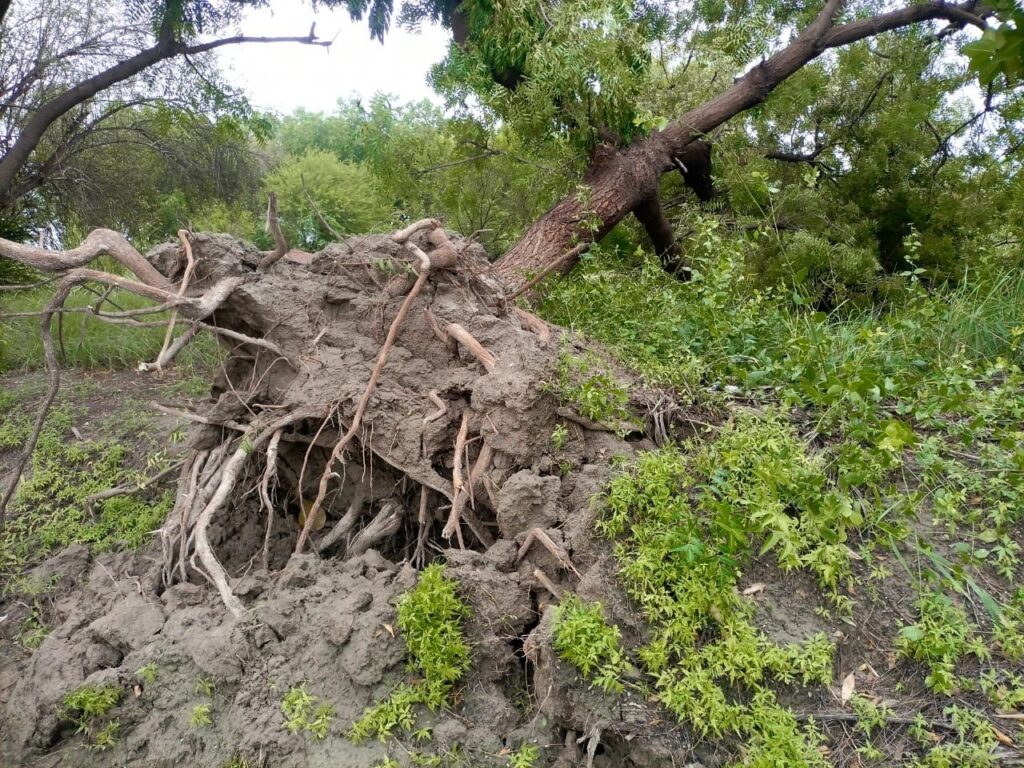
On September 11, 2022, at around 6.30pm, a tornado struck Deh Kak and Sanghro, situated in the outskirts of Mirpurkhas, Sindh. It caused extensive damage in a radius of around 1km. The storm lasted for three to four minutes only but it uprooted countless trees and blew off solar panels from rooftops. Many people got injured.
“I have not witnessed anything like this before. It felt like it was end of the world. All of a sudden, cold wind blowing at high speed surrounded us. Things started to fly around,” says Yaqoob, a villager.

Cyclones are not common in Pakistan. In the last two decades, around four tornados have hit different parts of the country. In March 2001, a tornado struck District Sargodha, in 2022 a tornado struck Sialkot which killed around 56 people and injured more then 600 people; in 2015 a tornado struck the outskirts of Peshawar which killed 44 people. They have mostly occurred in March and April due to the interaction of cold and hot air during the months.
The tornado that struck Mirpurkhas in September could be a result of climate change and increased energy in the atmosphere. One would also imagine that global warming should lead to more frequent tornados due to increased energy in the atmosphere that we are creating with greenhouse gasses. According to the National Geographic, “Is there a connection between tornados and global warming? Although there is an increase in number of tornadoes, a lot more are being recorded then in 1950, the intensity is slower”.
A lot more studies and research needs to be done to establish the fact that tornadoes are a direct result of global warming and climate change.
The September 11 tornado in the outskirts of Mirpurkhas took everyone by surprise. The local communities were not warned or prepared for the storm. As there is no precise tracking or prediction system for tornados, meteorologists can only identify conditions that are likely to lead to a severe storm. Warnings can be issued when atmospheric conditions are leading towards the development of a tornado. To minimize the impact of tornados a mass awareness campaign must be launched to save precious lives. A huge percentage of the population does not know what a tornado is and how to deal or act when it strikes.
Given the recent climate change and global warming impacts on Pakistan, the frequency of tornados may increase. More studies and research needs to be conducted and a strategy needs to be devised to keep the population safe from tornados in future. The National Climate Change Policy 2012 needs to reconsider its goal, and ensure that climate change is mainstreamed in the economic and socially vulnerable sectors. The policy must steer Pakistan towards climate compatible development.
“I have not witnessed anything like this before. It felt like it was end of the world. All of a sudden, cold wind blowing at high speed surrounded us. Things started to fly around,” says Yaqoob, a villager.

Cyclones are not common in Pakistan. In the last two decades, around four tornados have hit different parts of the country. In March 2001, a tornado struck District Sargodha, in 2022 a tornado struck Sialkot which killed around 56 people and injured more then 600 people; in 2015 a tornado struck the outskirts of Peshawar which killed 44 people. They have mostly occurred in March and April due to the interaction of cold and hot air during the months.
The tornado that struck Mirpurkhas in September could be a result of climate change and increased energy in the atmosphere. One would also imagine that global warming should lead to more frequent tornados due to increased energy in the atmosphere that we are creating with greenhouse gasses. According to the National Geographic, “Is there a connection between tornados and global warming? Although there is an increase in number of tornadoes, a lot more are being recorded then in 1950, the intensity is slower”.
The September 11 tornado in the outskirts of Mirpurkhas took everyone by surprise. The local communities were not warned or prepared for the storm.
A lot more studies and research needs to be done to establish the fact that tornadoes are a direct result of global warming and climate change.
The September 11 tornado in the outskirts of Mirpurkhas took everyone by surprise. The local communities were not warned or prepared for the storm. As there is no precise tracking or prediction system for tornados, meteorologists can only identify conditions that are likely to lead to a severe storm. Warnings can be issued when atmospheric conditions are leading towards the development of a tornado. To minimize the impact of tornados a mass awareness campaign must be launched to save precious lives. A huge percentage of the population does not know what a tornado is and how to deal or act when it strikes.
Given the recent climate change and global warming impacts on Pakistan, the frequency of tornados may increase. More studies and research needs to be conducted and a strategy needs to be devised to keep the population safe from tornados in future. The National Climate Change Policy 2012 needs to reconsider its goal, and ensure that climate change is mainstreamed in the economic and socially vulnerable sectors. The policy must steer Pakistan towards climate compatible development.

